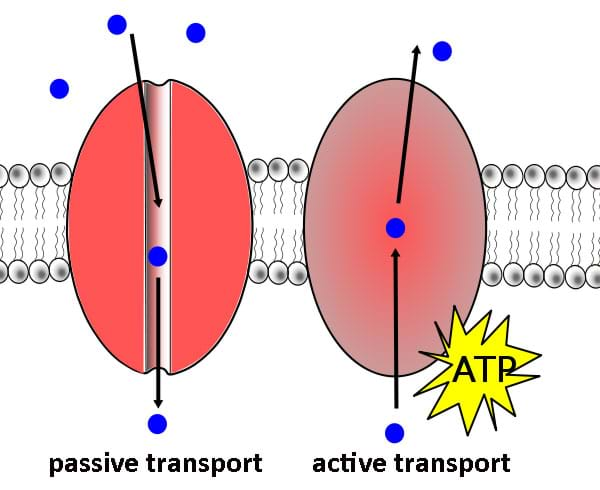Quick Look
Grade Level: 9 (9-12)
Time Required: 45 minutes
Expendable Cost/Group: US $0.00
Group Size: 1
Activity Dependency:
Subject Areas: Algebra, Biology, Chemistry, Data Analysis and Probability, Life Science, Measurement, Problem Solving, Reasoning and Proof, Science and Technology
NGSS Performance Expectations:

| HS-LS1-2 |
Summary
Students compare and contrast passive and active transport by playing a game to model this phenomenon. Movement through cell membranes is also modeled, as well as the structure and movement typical of the fluid mosaic model of the cell membrane. Concentration gradient, sizes, shapes and polarity of molecules determine the method of movement through cell membranes. This activity is associated with the Test your Mettle phase of the legacy cycle.
Engineering Connection
Engineers use models to represent and better understand the world at various scales. To better understand cells, engineers construct and manipulate models. In this activity, students construct a cell membrane and provide areas for specific transport. A molecule's ability to permeate through a cell membrane is one of the main focuses of intracellular engineering. A great deal of research is being done in the field of biomedical engineering to learn about the inner-workings of cells in order to develop new forms of medical technology.
Learning Objectives
After this activity, students should be able to:
- Act as a different particle or part of the cell membrane to model active and passive transport.
- Explain how particles are transported from one side of the cell membrane to the other.
- Explain why engineers use models.
Educational Standards
Each TeachEngineering lesson or activity is correlated to one or more K-12 science,
technology, engineering or math (STEM) educational standards.
All 100,000+ K-12 STEM standards covered in TeachEngineering are collected, maintained and packaged by the Achievement Standards Network (ASN),
a project of D2L (www.achievementstandards.org).
In the ASN, standards are hierarchically structured: first by source; e.g., by state; within source by type; e.g., science or mathematics;
within type by subtype, then by grade, etc.
Each TeachEngineering lesson or activity is correlated to one or more K-12 science, technology, engineering or math (STEM) educational standards.
All 100,000+ K-12 STEM standards covered in TeachEngineering are collected, maintained and packaged by the Achievement Standards Network (ASN), a project of D2L (www.achievementstandards.org).
In the ASN, standards are hierarchically structured: first by source; e.g., by state; within source by type; e.g., science or mathematics; within type by subtype, then by grade, etc.
NGSS: Next Generation Science Standards - Science
| NGSS Performance Expectation | ||
|---|---|---|
|
HS-LS1-2. Develop and use a model to illustrate the hierarchical organization of interacting systems that provide specific functions within multicellular organisms. (Grades 9 - 12) Do you agree with this alignment? |
||
| Click to view other curriculum aligned to this Performance Expectation | ||
| This activity focuses on the following Three Dimensional Learning aspects of NGSS: | ||
| Science & Engineering Practices | Disciplinary Core Ideas | Crosscutting Concepts |
| Develop and use a model based on evidence to illustrate the relationships between systems or between components of a system. Alignment agreement: | Multicellular organisms have a hierarchical structural organization, in which any one system is made up of numerous parts and is itself a component of the next level. Alignment agreement: | Models (e.g., physical, mathematical, computer models) can be used to simulate systems and interactions—including energy, matter, and information flows—within and between systems at different scales. Alignment agreement: |
State Standards
Tennessee - Science
-
Compare different models to explain the movement of materials into and out of cells.
(Grades
9 -
12)
More Details
Do you agree with this alignment?
-
Conduct an experiment or simulation to demonstrate the movement of molecules through diffusion, facilitated diffusion, and active transport.
(Grades
9 -
12)
More Details
Do you agree with this alignment?
Materials List
Materials needed for this activity include:
- yarn (or string)
- scissors
- hole punch
- Types of Transport Activity Page, one per student
- Red Rover Game Pieces (use the hole punch and yarn to make these game cards into student role identification placards; optional: laminate them so they are re-usable)
- Cell Membrane Quiz, one per student
Worksheets and Attachments
Visit [www.teachengineering.org/activities/view/van_membrane_activity3] to print or download.Introduction/Motivation
Today you are all going to participate in a cell membrane game called "Red Rover- Send Particles Over." This kinesthetic learning allows you to model and explore relationships within the cell involving the cell membrane. Active learning helps you to model what is happening on a molecular level so you can better understand processes that you are unable to visualize. You should have a chemical and biological understanding of the fluid mosaic model of the cell membrane and be familiar with the structure and polarity of molecules that will transport across the membrane. The act of modeling processes is a tool used by many engineers as they follow the steps of the design process in to solves problems and find good solutions.
Let's review passive and active transport:
Passive transport is the movement of substances across the membrane without any input of energy from the cell. Osmosis and diffusion (the focus of the previous lesson) are two examples of passive transport.
Active transport refers to movement of materials from an area of lower concentration to an area of higher concentration, against the concentration gradient. To do this, energy is required, usually from ATP. Cell membrane pumps, endocytosis and exocytosis (the focus of the previous lesson) all aid in active transport.
In the red rover game, you will physically "move" your body through a cell with either ease or constraints, depending on the type of transport specified.
Procedure
Background
Before starting the game, students review the activity sheet to familiarize themselves with the transport types and related topics. The teacher serves as the game facilitator, announcing the type of transport and summing up what has happened at the end of each session. During the activity, remind students about the concentration gradient and dynamic equilibrium.
Before the Activity
- Make copies of the Cell Membrane Quiz and Types of Transport Activity Sheet, one each per student.
- Print out the game cards that illustrate ions, molecules and cell membrane members. Hole-punch the cards on the top two corners and tie yarn through each to make placards for each student to wear during the activity, illustrating their roles. Use the pink atoms as potassium or another ion and write the ion element and charge on each. Have students write the charges on the sodium and chlorine atoms. (Tip: To make these cards re-usable, copy them onto card stock and laminate before punching the holes. Dry erase marker wipes off the laminated surface so the blank atoms can be easily changed.)
- Move aside desks and tables to clear a space to conduct the game. Or arrange to go outside or to the gym.
- Give students the activity sheet prior to the activity so they may familiarize themselves with the various types of transport being studied. Also have students review shape and structure of molecules to determine their polarity and method of movement into and out of the cell membranes.
With the Students
- Offer students the stack of game cards, face down, and have them randomly choose their roles in the game by choosing a card. Have them place the placards around their necks so everyone knows their roles in the game.
- Direct students who have drawn similar cards to group together to talk about their strategy for movement into the cell membrane. Suggest they look over the activity sheet to review what type of transport they are able to participate in each time. Likewise, have members of the lipid bilayer and the proteins discuss placement of their proteins within the membrane.
- Begin the game by announcing which transport type will be illustrated. Similar to playing "Red Rover," the particles try to enter the cell and still be aware of the dynamic equilibrium that takes place in conjunction with the concentration gradient. Have the cell membrane hold hands so as to be "fluid" enough for small particles such as water, carbon dioxide and oxygen gas to enter and exit the cell at will, while charged particles must enter and exit the cell only through their specific channel proteins. Have the channel proteins announce which specific ion they allow to enter and exit. Have the carrier proteins also announce their specific molecule, such as glucose or amino acids.
- Periodically stop to discuss what the students are modeling. Transition to new games by summarizing and discussing what happened. Restart new games, announcing different transport types. Periodically allow students to switch roles during the game so that they gain perspective for different parts of the process. Remind students about the concentration gradient and dynamic equilibrium.
- At activity end, administer the quiz.
Vocabulary/Definitions
active transport: The movement of substances through the cell membrane that requires energy.
passive transport: The movement of particles through the cell membrane that does not require energy.
Assessment
Quiz: At activity end, administer the Cell Membrane Quiz. Review students' answers to gauge their comprehension of the concepts.
Subscribe
Get the inside scoop on all things TeachEngineering such as new site features, curriculum updates, video releases, and more by signing up for our newsletter!More Curriculum Like This

Students learn about the different structures that comprise cell membranes, fulfilling part of the Research and Revise stages of the legacy cycle. They view online animations of cell membrane dynamics (links provided).

Students explore the structure and function of cell membranes. As they study the ingress and egress of particles through membranes, students learn about quantum dots and biotechnology through the concept of intracellular engineering.

Students learn that engineers develop different polymers to serve various functions and are introduced to selectively permeable membranes. In the main activity, student pairs test and compare the selective permeability of everyday polymer materials engineered for food storage (including plastic groc...

Students learn about the basics of molecules and how they interact with each other. They learn about the idea of polar and non-polar molecules and how they act with other fluids and surfaces. Students acquire a conceptual understanding of surfactant molecules and how they work on a molecular level. ...
Copyright
© 2013 by Regents of the University of Colorado; original © 2010 Vanderbilt UniversityContributors
Melinda M. HigginsSupporting Program
VU Bioengineering RET Program, School of Engineering, Vanderbilt UniversityAcknowledgements
The contents of this digital library curriculum were developed under National Science Foundation RET grant nos. 0338092 and 0742871. However, these contents do not necessarily represent the policies of the National Science Foundation, and you should not assume endorsement by the federal government.
Last modified: September 3, 2021







User Comments & Tips